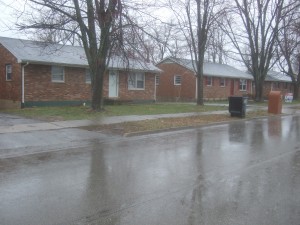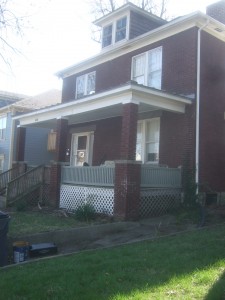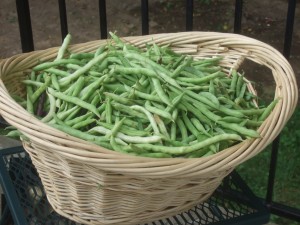Building a basil economy
By Danny Mayer
This is the fifth in a series calling on city council to actively facilitate the establishment of five public city farmer’s markets on public park land.
It’s too bad that, when given the chance in last November’s elections, Lexingtonians chose not to elect a grocer to represent them as one of three (3) at large city council members. Perhaps a former grocery store owner like Don Pratt might have responded with a bit more interest, experience and knowledge to a series of recent articles I’ve written on our local government’s need to actively promote better access to public farmer’s markets.
As it is, the three pieces I personally sent to all city council members save George Myers (whose emails still get returned to me) have thus far yielded two replies. One informed me that an outside group was looking at the topic and would report back to council at some undefined time in the future; the other refused help, in part because my ideas for having the city host five (5) weekly small farmer’s markets on city park lands scattered throughout Lexington did not constitute an example of “looking for opportunities and working on related issues as they arise.”
So while the people you all voted for mostly haven’t been interested in asking how exactly I envision city participation in starting park markets—even though over the past 5 weeks I’ve sent them three articles totaling 4500 words, all three of which have directly addressed them by rank—some others of you have asked me.
So here it goes. Decide for yourself if these ideas are, apparently, so far-fetched that they have yet to elicit a city council follow-up along the lines of, “Hey constituent, how would that work?”
Problem: (small) Solution
The majority of city funding and resources this past decade have focused on the development of Lexington’s downtown. Recently released 2010 census data, however, indicate that downtown’s population has decreased thirteen percent, and that the greatest percentage of those leaving downtown seem to have been black and hispanic residents. As the city continues to discuss high dollar projects like creative Rupp renovations and bourbon soaked TIF funds, several of the city’s historically poor and marginalized demographic groups seem to be disembarking from the very places the city has directed its money and energy.

These suburban homes around River Hill Park comprise one of the most dense parts of the city--way out by Man O War Boulevard. Density might help sustain a park market.
The primary purpose of park markets is to ensure that increasingly important community sources of food are available throughout the city, rather than in the city’s core, where most Lexington farmer’s markets currently reside. Unlike freakishly expensive downtown projects for private development, locating small markets on public city land may thus act as a force pushing the city to better allocate its capital—financial, social, creative, human—to the needs of the people living throughout its confines rather than to those of the diminishing wealthy few in the city center. Things grow from this concept.
While the goal should be self-funding markets, as it does with TIFF funds the city can absorb early losses to support a future for places and businesses that the city deems desirable. City leaders direct many millions in public money to maintain Lexington’s expensive competitive market advantages in, say, the horse industry, or the Rupp Arena industry, or the creative class industry, or the Top 20 university industry. In interfering in the as yet uncompetitive Suburban Farmer’s Market market, city funded park markets can also develop, much more cheaply than TIFF, demand for private sector products like tomatoes, butternut squash, honey, borage and the like.
In other words, for way less money, the city can more directly impact the lives of Lexington citizens, most of whom do not live downtown, and in the process it can generate new businesses more efficiently.
Nuts and bolts in bullet format for policy wonks
Size: Small. Two to three vendors at the maximum for the first season, unless unexpected demand and capacity to meet demand both occur. Aiming small keeps the city’s initial monetary investment small, and it doesn’t demand immediate community buy-in and participation. It allows the city to manage markets more effectively, and the community to build trust in the institution. The communities using it are able to weave their needs and products into its growth.
Days/times:Ideally, park markets would develop their own operating hours of as a way to supplement, not compete with, other nearby park markets and farmer’s markets. If it were me, I would look to early evening hours, 4:00-6:00 or 5:00-7:00, weekdays, as a way to attract workers getting off work and locavore freaks roving the city for fresh veg daily.
Beginning? Ending?: As smaller markets, these should begin later and end earlier than the larger markets. June-early October, perhaps, when the night darkens sooner.
Whose food you selling?: This is one of the main reasons why city council support is vital for developing park markets. Conceivably, finding producers willing to sell their produce at city markets outside of downtown might be difficult, or at the very least require certain inquiries from certain people.
But there are producers to ask. The Lexington’s Farmer’s Market has over 65 vendors who sold $2.7 million dollars of products last year. The Bluegrass Farmer’s Market on Richmond Road has developed a network for local, and sometimes micro-scale, producers for over five years now. UK’s South Farm and its sustainable agriculture graduates might be of help. BCTC’s Peace Meal Gardens is already committed to providing fresh produce. If advertised and supported, perhaps some efficient backyard growers looking to start a side-venture might be tempted to turn their backyard into okra and tomato or asparagus and cilantro fields.
Next year, the city could employ its own rural parks to grow food for the market. The increased profit margin accrued from city park producers not having to pay lease on the land, ideally, could be funneled back into the necessary administrative and infrastructure costs necessary to continue growing market access to all citizens. Long term, markets should encourage a class of nearby growers to supplement the market.
The point here is this: there are lots of potential producers out there to satisfy demand for 2-3 stalls at 5 different locations in the city.
The problem is, if I tell people to grow extra veg to get ready for a market, I’m just a schlub with his own paper. I’ve got no credibility. Having a city council member declare council support for supporting new markets on city land, much like Gray seems to be doing for the Rupp re-do, that sort of thing has a different sort of credibility. Yet with a little advance warning and planning, park markets could act as the minor leagues of Lexington farmer’s markets, growing the next generation’s hot agricultural prospects, farmers who dream of one day being drafted into the “Bigs” and selling under the rooftops of the hallowed Fifth Third.
Costs? In starting small, costs remain small. Human capital might include someone charged with oversight to be present on market days, chief organizers for each location who report directly to council, staffing to aid vendors and some sort of community police authority. Human labor could be paid in produce (encouraged) or if necessary in dollars, as a portion of market income. Ideally, labor will comprise a mixture of community, producer and city participation. Certain non-barter-able monetary outlays include advertising (photo-copied fliers delivered to residents located in a pre-determined area) and other miscellaneous expenses.
Mostly, though, costs to council should be minimal. We’re talking two (2) to three (3) vendors apiece to start at five different locations. For something this small people mainly just need a place, minimal but committed organization, and a group working to drumming up customers and interest.
Site selection: Duncan Park and River Hill
Lest this discussion get overly and unnecessarily abstract, let’s look at two potential park market sites: Duncan Park and River Hill Park.
Sitting on the corner of North Limestone and Fifth Streets, Duncan Park is my neighborhood park. It has a number of things going for its use as a park market. The park’s small size and urban-residential location make it well-suited to pedestrian patronage. The park is highly visible from a number of pedestrian boulevards running north/south along Limestone and MLK, and east/west down Fifth.
The MLK, North Limestone and William Wells Brown neighborhoods that the park touches provide the market with a large and diverse potential customer base. Discounting the UK campus, Duncan Park is located within walking distance of four of the most dense urban tracts in the city, according to recent census figures. Those same figures also show that these same tracts are undergoing a stark transformation as predominantly white residents (me) with more spending money move in and displace older residents whose smaller incomes had dictated the earlier flight of private business from the neighborhood. .
Duncan Park, in particular, sits at a crossroads of this shift. To its south, new money has moved onto streets like Johnson Drive or the 400 block of MLK; to its east along Fifth Street heading toward Shropshire, poorer residents inhabit weather worn rental homes. Placing a market at Duncan would have the twinned benefits of providing fresh food to poorer residents to the east and north, at the same time of catering to the the more hopeful gentrifying desires of nearby streets and its wealthier hinterlands like Gratz Park and Castlewood. (But that’s just walking distance. Duncan Park is within easy commute for the bike communities surrounding UK, along Jefferson Street, and in the punk retirement community of Kenwick.)

The Duncan Park neighborhood has seen a revival in Yuppies moving back to the city to live in large homes. These social deviants can, at the least, help support a market directed to the entire neighborhood.
The park also has other benefits: two years ago, North Limestone activist Marty Clifford organized the construction of a music stage on the park grounds, so the area already has an established meeting place and a nearby champion of the park in Marty. Perhaps city leaders could use Marty, the stage, nearby bike organizations like Broke Spoke, and a media outlet like North of Center to help establish a weekly market in a location that has been openly referred to as a food desert, and that has been covertly allowed to gentrify (and be celebrated for it).
Moving outside of downtown, River Hill Park off Crosby Lane would make for another good park market location. Decidedly suburban in its southeast Lexington location just inside Man O Wa, River Hill nevertheless sits in one of the most dense tracts of the city. The park is a hub for the area bounded by Tates Creek to the west, Man O’War to the south and east, and Armstrong Mill to the north. 2010 census data indicate that, at 6600 people per mile, this part of Lexington has greater density than downtown. Outside of UK, only the Duncan Park census tract has a higher population density, and unlike downtown, this part of Lexington—including the Hartland census tract and the new construction around nearby Veterans Park—is attracting new population demographics. The area around the park has grown 5% in the past decade, with black, hispanic and multi-racial residents making the most gains (and whites leaving the precinct at a 7% clip).
Situated amidst a diverse number of middle class 1960s era suburban ranch homes, new large homes on small lots, and (directly across Man O War) a luxury apartment complex, the market would potentially most benefit residents of a street like Red River Drive. The street runs behind the park and has a number of 1000 square foot homes, some backing up to the park, with average property values at below market values of $80-100 thousand. Bolstering the buying power of these neighborhoods, ideally, would be the money spent at the market by the wealthier residents of the luxury apartments across Man O War.
Like Duncan Park, River Hill also has other benefits. Council Member George Myers, district rep for the area, has spent time working on revitalizing River Hill. His website used to feature him, clad in a hard-hat, working on the park’s playground equipment. His efforts have paid dividends, at least during my trips there playing disc golf, when I’ve seen a number of neighborhood kids from nearby homes and apartments play games in the baseball diamond and upon the basketball courts, as well as upon the playground. Tapping into CM Myers interest in the park could provide the market a public champion.
Other potential contributors might include members of the Bluegrass Disc Golf Association, who hold occasional gatherings at the park. Linking regularly scheduled, weekly markets with (potentially) regular weekly disc golf gatherings could draw in a new market audience for both the BDGA and the LFUCG. One might play a round and leave with their fresh veg for the week; or maybe mom plays a round while dad shops with the kids.





Leave a Reply